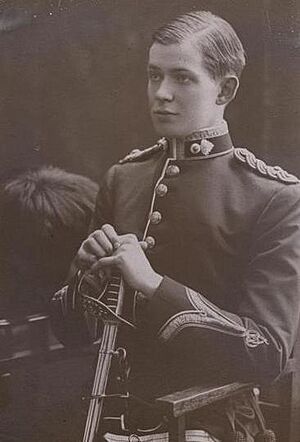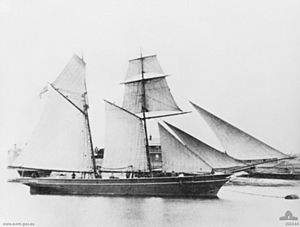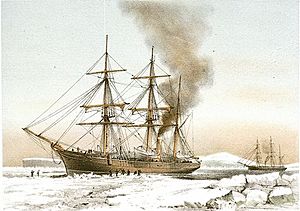Belgrave Ninnis facts for kids
Quick facts for kids
Belgrave Ninnis
|
|
|---|---|
| Born | 1 September 1837 London, England |
| Died | 18 June 1922 (aged 84) Streatham, England |
| Allegiance | |
| Service/ |
|
| Years of service | 1861–97 |
| Rank | Inspector-General |
| Awards | Arctic Medal Sir Gilbert Blane's Gold Medal |
| Other work | Surveyor Arctic explorer Freemason |
Belgrave Ninnis (born September 1, 1837 – died June 18, 1922) was an important figure in the Royal Navy. He was a surgeon, a mapmaker (surveyor), and an explorer who traveled to the Arctic. He was also a leading member of the Freemasons, a well-known social group.
Ninnis was born in London, England. He became a doctor in 1861 and joined the Royal Navy as a junior surgeon that same year. He took part in several exciting expeditions and made important discoveries. He also helped improve medical care in the Navy.
Contents
Belgrave Ninnis: An Explorer's Life
Early Adventures and Discoveries
Belgrave Ninnis became a Doctor of Medicine in 1861. Soon after, he joined the Royal Navy Medical Service as an Assistant Surgeon. His first ship was HMS Pantaloon. Later, he moved to HMS Victory and then to HMS Curacoa, which was sailing near Australia.
Exploring Australia's Coast
In 1864, Ninnis joined a special trip to the Northern Territory in Australia. He was the "naturalist" on the ship HMS Beatrice. A naturalist studies nature, like plants and animals. The goal of this trip was to map the coast around the Adelaide River. They wanted to find a good spot for a new city.
Ninnis was one of the first to map the area where the city of Darwin is today. He collected many samples of reptiles, birds, and different types of wood. These samples helped people understand the nature of the area. He also studied the rocks and found that the coast was mostly made of red and grey sandstone.
People were very thankful for Ninnis's work. His discoveries helped show that the area had plenty of timber. His research from this trip was later published in a book.
Arctic Challenges and Discoveries
After returning to Britain, Ninnis became a full Surgeon in the Royal Navy. In 1875, he joined the British Arctic Expedition on HMS Discovery. This expedition, led by Captain Sir George Nares, aimed to be the first to reach the North Pole.
The ships sailed slowly through thick ice. During the journey, the expedition's Greenland Dogs became sick. Ninnis was asked to find out why. He studied the dogs' illness, which seemed similar to rabies. His findings were very important for understanding animal diseases in cold places.
Battling Scurvy and Dog Illnesses
Ninnis also tried to grow plants on the ship, like wheat, mustard, and peas. This experiment showed how hard it was to grow fresh food in the Arctic.
The expedition did not reach the North Pole. Sadly, some men died from scurvy, a disease caused by not having enough Vitamin C. Ninnis and the other doctors worked hard to care for the crew. Even though there were challenges, Nares praised his surgeons, including Ninnis, for their dedication.
For his hard work in the Arctic, Ninnis received the Arctic Medal. He was also promoted to Fleet-Surgeon. He later wrote a report about the diseases he found in the Eskimo dogs during the expedition.
Later Life and Important Ideas
Ninnis spent the rest of his career working on ships and in hospitals. In 1879, he received a special award for Royal Navy medical officers. He was promoted to Deputy Inspector-General in 1883. He became the main medical officer at Melville Naval Hospital in 1892. In 1897, he retired and was given the honorary rank of Inspector-General.
A Vision for Hospital Ships
Even after retiring, Ninnis stayed active. He served as President of the Navy, Army, and Ambulance section of the British Medical Association. In 1900, he gave a speech about how to treat wounded sailors. He believed that wounded sailors needed fresh air and light, which was hard to get below deck during a battle.
Ninnis suggested using special hospital ships. These ships would stay away from the fighting but close enough to pick up wounded sailors after a battle. He argued that these ships, following the rules of the Geneva Convention, would be safe from attack. This was a very forward-thinking idea!
In 1912, King George V honored Ninnis by making him a Commander of the Royal Victorian Order (CVO). Belgrave Ninnis passed away in 1922 at the age of 84.
What is a Freemason?
Belgrave Ninnis joined the Freemasons in 1872. The Freemasons are one of the oldest and largest social groups in the world. They are known for their traditions, symbols, and for doing charity work. Ninnis was a very important member, helping to start several local groups called "Lodges." He also held high positions within the organization, like Past Grand Deacon of England.
His Explorer Son

Belgrave Ninnis had three sons and one daughter with his wife, Ada Jane Sutton. One of his sons, also named Belgrave Edward Sutton Ninnis, became an explorer like his father.
B. E. S. Ninnis joined the 1911–14 Australasian Antarctic Expedition led by Douglas Mawson. He was in charge of the sled dogs. Sadly, on December 14, 1912, while exploring in Antarctica, B. E. S. Ninnis fell into a deep crack in the ice called a crevasse and died.
When news of his son's death reached Australia, many newspapers wrote about Belgrave Ninnis senior. They remembered his own adventures in Australia and the Arctic. When Mawson returned from Antarctica, a message was sent to Belgrave Ninnis, expressing sadness for his loss but also pride in his son's bravery and lasting fame.



